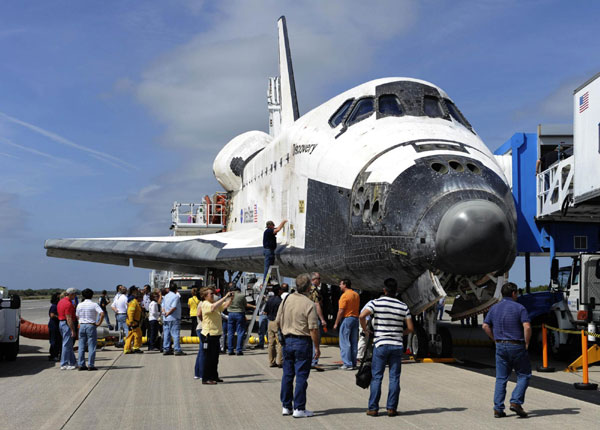Museums compete for space shuttles
 |
|
The space shuttle Discovery sits on the runway after landing at the Kennedy Space Center in Cape Canaveral, Florida, March 9, 2011. [Photo/Chinadaily.com.cn via Agencies] |
After the Discovery lands, only two shuttle flights remain. The Endeavour is scheduled to launch in April, and the Atlantis in June.
Then the three will become museum pieces, with delivery expected next year. Each weighs about 77,111 kg and is 37 meters long, with a wingspan of 24 meters.
There is also a fourth orbiter, the Enterprise, which was used for early glide tests but never went to space. The Smithsonian's National Air and Space Museum has the Enterprise on display at its spacious Steven F. Udvar-Hazy Center near Washington-Dulles Airport.
A couple of years ago, NASA inquired if any museums or other institutions had an interest in acquiring one of the three flying space shuttles.
Potential bidders were told that educational programs had to accompany the exhibits and that the shuttles had to reside in an indoor, climate-controlled environment.
NASA does not want to repeat the mistake at the end of the Apollo era, when the remaining Saturn V rockets rusted and decayed outdoors.
Since then, NASA has been mostly silent.
"We've not been contacted since we submitted," said Richard E. Allen Jr, chief executive of Space Center Houston, the visitor center at Johnson.
After it lands, the Discovery will go through a month of routine postflight rituals, like the removal of payloads. But then, instead of beginning preparations for another flight, workers will start preparing it for its new life as a tourist attraction. That work - which accounts for most of the $28.8 million that NASA is charging - will include cleaning or removing parts that have been contaminated by toxic propellants and will likely take nine months to a year.
The Discovery will probably end up at the Air and Space Museum.
NASA offered it there three years ago, but the Smithsonian has been reticent about whether it will accept.
A museum spokeswoman offered only a short statement: "The museum is involved in discussions with NASA about transfer of the orbiter and other artifacts from the shuttle program. The final disposition of shuttle artifacts will be the decision of NASA."
After concerns that the Smithsonian could not afford $28.8 million, Congress, in a budget bill passed in December, included a clause that specifically excuses the Smithsonian from those costs.
If NASA offered a shuttle to the Smithsonian, the bill decreed, it would be "at no or nominal cost".
The visitor complex at the Kennedy Space Center has proposed what would probably the most ambitious display: While most of the museums would have the orbiter sitting on the ground and build a fancy hangar around it, Kennedy would like to suspend it horizontally as if it were in Earth's orbit, with the payload doors open and the robotic arm sticking out.
It would be the centerpiece of a $100 million, 5,946-square-meter exhibit that would open in the second half of 2013.
 0
0 







Go to Forum >>0 Comments